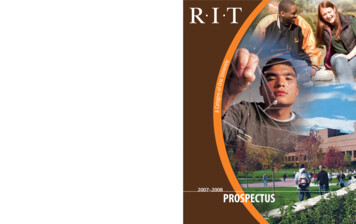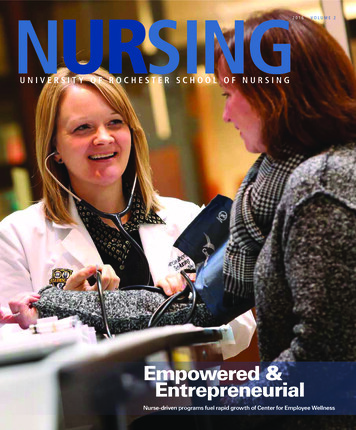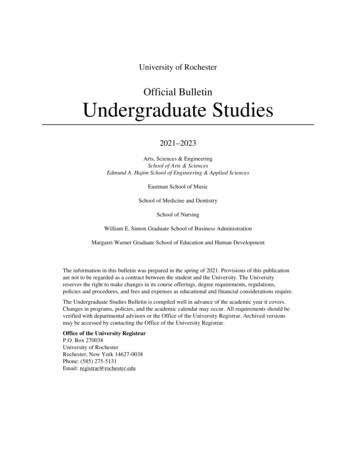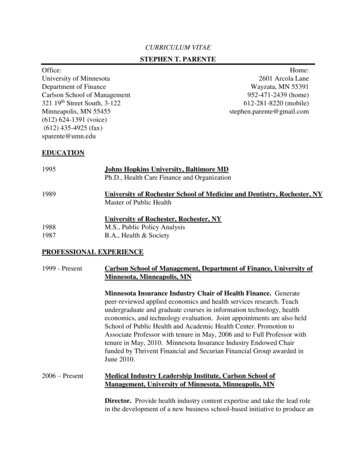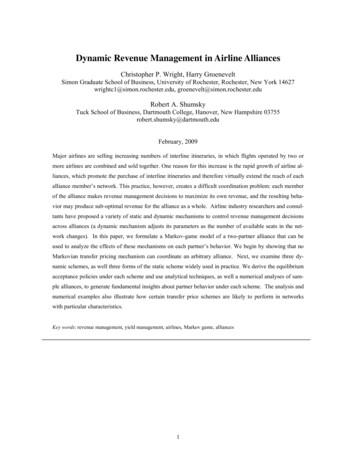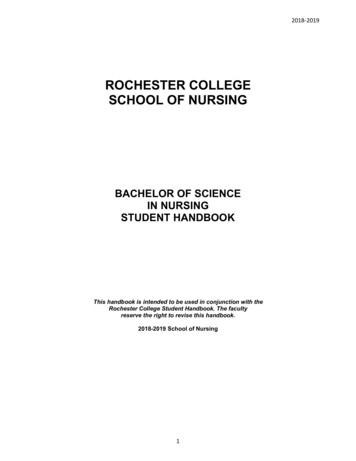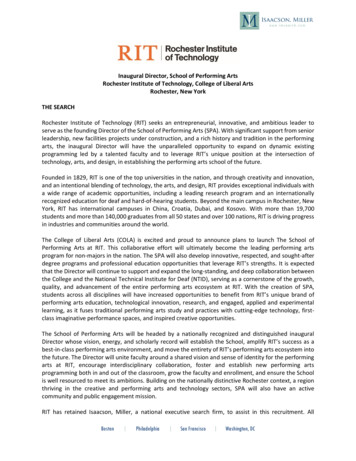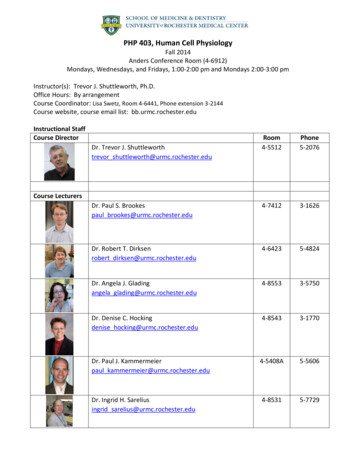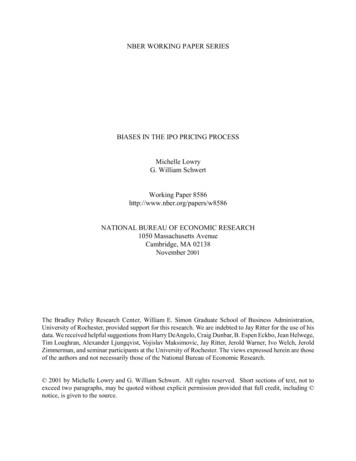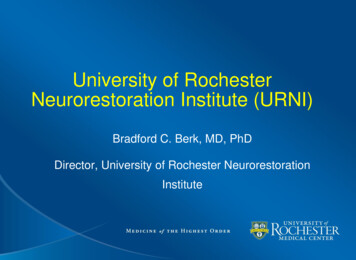
Transcription
University of RochesterNeurorestoration Institute (URNI)Bradford C. Berk, MD, PhDDirector, University of Rochester NeurorestorationInstitute
Content of presentation1. URNI: rationale, mission, vision, book2. Programs ClinicalResearchTeachingCommunity3. URNI – UR Clinical and Basic Research Programs DevicesPainRegenerative Medicine: stem cells, drugs, and scaffoldsNeuroplasticityIntegrative Medicine4. Neuromedicine and URNI ambulatory building2
1. University of Rochester Neurorestoration Institute (URNI):Rationale, Mission, Vision and Book Rationale: Unique moment in medicine and neurologic disease – decade ofthe brain; epidemic of dementia and memory loss; improved functionalimaging; dramatic advances in preclinical models, biomarkers, data science,devices (adaptive, brain-machine, and prosthetic) and new drugs. Mission: To bring the highest quality and most innovative approaches torestore function in individuals who have suffered damage to their brain,spinal cord, and peripheral nerves. Vision: To be a national destination for rehabilitation of people with chronicneurologic conditions, and a center for excellence in research on restorationof cognitive, motor, and sensory function. Book: Using the Mind to Heal the Brain and Body: A Guide for Recoveryfrom Spinal Cord Injury, Stroke, and Traumatic Brain Injury.3
1. URNI Book Title: Using the mind to heal the brain and body: A guide torecovery from spinal cord injury, stroke, and traumatic brain injury. Themes: A self-help book for patients, families, and providersfocused on post-acute care. Psychological features of these 3 diseases are consistent with anacute traumatic event. Hence, the prevalence of psychological diseaseis very high - anxiety, depression and PTSD in 75. Mind is really a code word for neuroplasticity. The innovative conceptis that patients in the chronic stage after injury ( 1 year) can makesignificant improvements in functional recovery through focusedmental efforts. The approach to improving outcomes is similar to acute myocardialinfarction. My personal experiences as a cardiologist in the 1980’sand 1990’s provide me a “crystal ball”.4
2. URNI Programs Clinical: Provide multidisciplinary care to patients with stroke,traumatic brain injury (TBI), spinal cord injury (SCI), andperipheral nerve injury. Research: Provide patients, equipment, rehabilitation space,clinical care coordinators, and office space for clinical trials.Simply put, URNI will be the clinical “arm” for research byinvestigators in the Ernest J. Del Monte Institute forNeuroscience. Key research areas will include: devices, pain,stem cells, neuroplasticity, and integrative medicine. Education: Educate the next generation of clinicians andresearchers who will become leaders in the field ofneurorestoration Advocacy: Develop programs to raise societal consciousness,stimulate government and philanthropic support5
2. Clinical Programs: Typical Visit for a PatientHead to toe exam with URNI team led by PMR physician Psychologist Pain specialist Urology Gastroenterology Wound care specialist Physical Medicine and Rehabilitation (PT/OT) Neurology and neurosurgery Integrative medicine Nutrition and exerciseAt the end of the day – comprehensive diagnosis andtreatment plan, clinical trials eligibility, and referrals.6
3. URNI Clinical Research Resources Patients, patients and more patients Develop a large clinical trials network in US andinternationally Physicians from PM&R and Neurology will coordinate eachpatient’s visit for clinical evaluation. Based on patient’sclinical and restorative needs, appropriate clinical trialseligibility will be discussed Eligible patients who desire to enter clinical trials will returnfor enrollment Equipment and therapists for trials will be present at URNI for“one stop shopping” whenever possible7
3.1 Devices: Robot Training8
3.1 Devices: Robot TrainingJune 6, 2015October 27, 20159
3.1 Devices: Robot Learning PPGDevices – robots, exoskeletons, nerve-stimulators, brain-machineinterface, scaffolds, prosthetics, adaptive and recreational devices,outcome measures (Kinetic with Dave Mitten), and virtual realityRobot and Learning PPGHypotheses: Enhanced learning can improve functional recovery inpatients with chronic neurologic injury. Test drugs and devices usinghand and arm robot. Measure kinematic parameters quantitativelywith the robot and functional changes with standardized tasks.1. Drugs that enhance nerve function, such as 4-aminopyridine(4-AP or Ampyra)2. Drugs that improve learning3. Transcranial electrical stimulation and transcranial magneticstimulation4. Artificial intelligence to develop personalized learningapproach10
3.2 Pain: drugs, devices, integrative medicineIntegrative medicine – acupuncture, chiropractic,hypnotherapy, massage, meditation, mindfulness, movementawareness therapy, nutrition, spiritualism, tai chi, yogaIntegrative Medicine – Pain PPGHypothesis: Combined therapy with one or more integrativemedicine approaches will improve pain and function. Forexample, compare acupuncture alone versus acupunctureplus meditation.a. Mindfulnessb. Meditationc. Acupunctured. Medical marijuana11
3.3 Regenerative MedicineSpinal cord injury nerve regeneration PPGHypothesis: Early intervention in SCI with multiple modalitieswill restore sensory and motor function Stem Cells: Patient specific astrocytes for treating acute andchronic SCI (Proschel, Noble) Scaffolds for nerve regrowth Drugs to mobilize and differentiate stem cells Drugs to promote nerve regrowth12
3.4 NeuroplasticityMultidisciplinary approaches to improve function PPGHypothesis: Combined treatment modalities in acute andchronic stroke patients will improve functional recovery Visual training to improve field of vision in patients withcortical blindness (Huxlin) Drugs to promote learning Drugs to promote neuroplasticity Gait training to improve walking with brain-machine interface,using biosensors to stimulate spinal motor interneurons13
3.5 URNI: Integrative MedicineIntegrative medicine approaches to improve pain PPGHypothesis: Combined treatment modalities in acute andchronic stroke patients will improve functional recovery Focus on mind healing brain and body: Acupuncture, learning, meditation, mindfulness,and yoga Combine with PPGs on pain, neuroplasticity anddevices14
4. Ambulatory Neuromedicine Building Preliminary size estimate - 90,000 gross sq.ft. (3 floors) URNI Neurosurgery Neurology Physical Medicine and rehabilitation Lobby linked to Imaging and Pediatrics Building 500-600 parking spaces 2 1/2 years to Design and Build15
4. South Campus Ambulatory Buildings19
4. East River Road ViewImaging/Peds Building for illustration2
18
1. URNI Book Title: Using the mind to heal the brain and body: A guide to recovery from spinal cord injury, stroke, and traumatic brain injury. Themes: A self-help book for patients, families, and providers focused on post-acute care. Psychological features of these 3 diseases are consistent with an acute traumatic event. Hence, the prevalence of psychological disease
